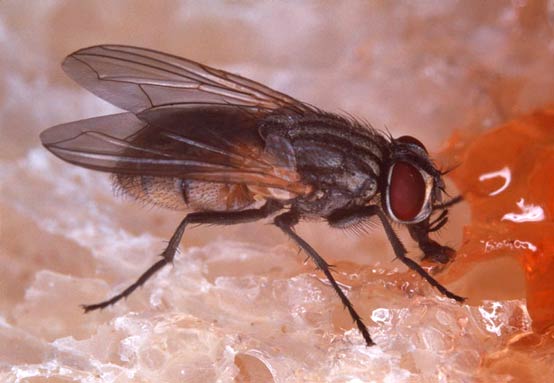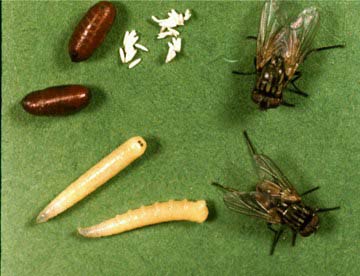
(The Common Housefly)
This is the one which everybody knows. It breeds all over the world in and around houses, rubbish dumps in fact anywhere where there is decaying organic matter...and we certainly throw plenty of that away. It has been suggested that this fly came originally from Africa but nowadays it has followed us to all parts of the earth. In Northern Europe it probably didn't become established until man started keeping domestic animals indoors during the winter, a practice that didn't start until about the beginning of the Iron Age, c. 400 B.C.
Life Cycle and Description
The housefly has a complete metamorphosis with distinct egg, larva or maggot, pupal and adult stages. The house fly overwinters in either the larval or pupal stage under manure piles or in other protected locations. Warm summer conditions are generally optimum for the development of the house fly, and it can complete its life cycle in as little as seven to ten days, and as many as 10 to 12 generations may occur in one summer.
Egg: The white eggs, about 1.2 mm in length, are laid singly but pile up in small masses. Each female fly can lay up to 500 eggs in several batches of about 75 to 150 eggs, each over a three to four day period. The number of eggs produced is a function of female size, which is principally a result of larval nutrition.

Larva: The mature larva is 3 to 9 mm long, typical creamy whitish in color, cylindrical but tapering toward the head. The head contains one pair of dark hooks. The posterior spiracles are slightly raised and the spiracular openings are sinuous slits which are completely surrounded by an oval black border. The legless maggots emerge from the eggs in warm weather within eight to 20 hours, and they immediately feed on and develop in the material where the eggs were laid. The full-grown maggots have a greasy, cream-colored appearance and are 8 to 12 mm long. The larvae go through three instars. When the maggots are full-grown, they crawl up to 50 feet to a dried, cool place near breeding material and transform to the pupal stage. High manure moisture favors the survival of house fly larvae.
Pupa: The pupae are dark brown and 8 mm long. The pupal stage is passed in a pupal case formed from the last larval skin which varies in color from yellow, red, brown, to black as the pupa ages. The emerging fly escapes from the pupal case through the use of an alternately swelling and shrinking sac, called the ptilinum, on the front of its head which it uses like a pneumatic hammer.
Adult: The house fly is 6 to 7 mm long, with the female usually larger than the male. The eyes are reddish and the mouth parts are sponging. The thorax bears four narrow black stripes and there is a sharp upward bend in the fourth longitudinal wing vein. The abdomen is gray or yellowish with dark midline and irregular dark markings on the sides. The underside of the male is yellowish. The sexes can be readily separated by noting the space between the eyes, which in females is almost twice as broad as in males.
Adults usually live 15 to 25 days. The potential reproductive capacity of flies is tremendous, but fortunately can never be realized. It has been stated that a pair of flies beginning operations in April may be progenitors, if all were to live, of 191,010,000,000,000,000,000, flies by August. Adults suck liquids containing sweet or decaying substances. Larvae feed on moist food rich in organic matter. Although they are attracted to a variety of food material, house flies have mouth parts which allow them to ingest only liquid materials. Solid materials are liquified by means of regurgitated saliva. The flies are inactive at night, with ceilings, beams and overhead wires within buildings, trees, and shrubs, various kinds of outdoor wires, and grasses reported as overnight resting sites. In poultry ranches, the outdoor aggregations of flies at night are found mainly in the branches, and shrubs, whereas almost all of the indoor populations generally aggregated in the ceiling area of poultry houses.
House flies visit dung, carrion, and offal of all kinds and naturally they pick up bacteria and viruses. They therefore act as carriers of diseases and are wholly undesirable from a hygienic viewpoint. More than 100 pathogens associated with the house fly may cause disease in humans and animals, including typhoid, cholera, bacillary dysentery, tuberculosis, anthrax ophthalmia and infantile diarrhea, as well as parasitic worms. Pathogenic organisms are picked up by flies from garbage, sewage and other sources of filth, and then transferred on their mouthparts and other body parts, through their vomitus, faeces and contaminated external body parts to human and animal food. In addition they can be intensely irritating when they occur in great swarms, settling on man and beast alike.
Damage
Flies commonly develop in large numbers in poultry manure under caged hens, and this is a serious problem requiring control. The control of Musca domestica is vital to human health and comfort in many areas of the world. The most important damage related with this insect is the annoyance and the indirect damage produced by the potential transmission of more than 100 pathogens associated with this fly.
Economic Injury Level
The threshold density for determining when to control flies depends on the area where the control measures will be taken. In general, at homes the threshold is very low and control actions are taken with few flies The complaint threshold density of the house fly at waste management sites may be 150 individuals per flypaper per 30 minutes. House flies are monitored with baited traps, sticky ribbons, or spot cards on livestock facilities. Spot cards are 3-inch by 5-inch white index cards attached to fly resting surface. A minimum of five cards should be placed in each animal facility and left in place for seven days. A count of 100 or more fecal or vomit spots per card per week indicates a high level of fly activity and a need for control.
Management
The more common control measures involved with the control of house flies are sanitation, use of traps, and insecticides, but in some instances integrated fly control has been implemented. The use of biological control in fly management is still at a relatively early stage.
Sanitation or Cultural Control: Good sanitation is the basic step in all fly management. Food and materials on which the flies can lay their eggs must be removed, destroyed as a breeding medium, or isolated from the egg-laying adult. Since the house fly can complete its life cycle in as little as seven days, removal of wet manure at least twice a week is necessary to break the breeding cycle. Wet straw should not be allowed to pile up in or near buildings. Since straw is one of the best fly breeding materials, it is not recommended as bedding. Spilled feed should not be allowed to accumulate but should be cleaned up two times a week. Ordinarily, fly control from 1 to 2 km around a municipality will prevent ingress of the house fly into a municipality. Killing adult flies may reduce the infestation, but elimination of breeding areas is necessary for good management. Garbage cans and skips should have tight-fitting lids and be cleaned regularly. Dry and wet rubbish should be placed in plastic rubbish bags and sealed up. All waste receptacles should be located as far from building entrances as possible. For control at waste disposal sites, refuse should be deposited onto the same area as inorganic wastes to deteriorate the capacity of breeding resources, or the disposed refuse should be covered with soil or other inorganic wastes (15 cm thickness) on every weekend or every other weekend.
Traps: Fly traps may be useful in some fly control programs if enough traps are used, if they are placed correctly, and if they are used both indoors and outdoors. House flies are attracted to white surfaces and to baits that give off odors. Indoors, ultraviolet light traps collect the flies inside an inverted cone or kill them with an electrocuting grid. One trap should be placed for every 30 feet of wall inside buildings, but not placed over or within five feet of food preparation areas. Recommended placement areas outdoors include near building entrances, in alleyways, beneath trees, and around animal sleeping areas and manure piles. Openings to buildings should be tightly screened with standard window screen, thereby denying entrance to flies.
Biological Control: With increasing incidence of insecticide resistant house fly populations, rising costs of insecticides and a growing public concern about actual or potential problems associated with insecticides, interest in alternative house fly control strategies has increased.Integrated fly control: Integrated fly control programs for caged-poultry houses are based on the following strategy 1) selective applications of insecticides against the adult, 2) start insecticide control measures early in the spring before flies appeared and repeated as frequently as needed through the warm months, and 3) the manure is left undisturbed throughout the warm months when fly breeding may occur. The manure would be removed once very early in the spring before any flies appear.
Insecticides: When the house fly is a mayor pest in commercial egg production facilities, the control of this insect is by the application of adulticides, or larvicides to directly or indirectly suppress adult densities. Residual wall sprays can be applied where the flies congregate. Resistance to permethrin develops more rapidly in fly populations from farms on a continuous permethrin regime than in farms in which permethrin and diclorvos have been alternated.
Outdoors, the control of flies includes the use of boric acid in the bottom of skips, treatment of vertical walls adjacent to skips and other breeding sites with microencapsulated or wettable powder formulation, and the use of fly baits near adult feeding sources. In areas like rubbish tips dusting powders can be used, applied with a machine called a MotoBlo, which gives dispersal over a large area. This treatment should always be carried out by a registered pest control company as there are many regulations to be observed.
Indoors, the control of flies includes automatic misters, fly paper, electrocuting and baited traps that can be used in milking parlours and other areas of low fly numbers.Sometimes tiny invertebrates can be found hanging on to the legs and abdomen of the fly. These may be mites of various kinds or false scorpions. This is how this type of small insect is transported from place to place. In all cases these are species which live on or near dung where the flies develop and they only release their grip when they come near more manure....a scented existence...so there is no danger of them becoming established indoors...
